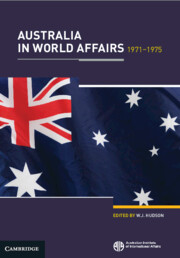Book contents
- Frontmatter
- Contents
- Preface
- I Defence Policy
- 2 Defence Reorganisation 1957–75
- 3 Investment
- 4 Immigration
- 5 International Law
- 6 The United Nations
- 7 The United States
- 8 The United Kingdom
- 9 Japan
- 10 China
- 11 South-East Asia
- 12 The Indian Ocean
- 13 South-West Pacific
- 14 Papua New Guinea
- 15 A Day in The Life of An Ambassador
- Notes
- Index
I - Defence Policy
Published online by Cambridge University Press: 29 March 2024
- Frontmatter
- Contents
- Preface
- I Defence Policy
- 2 Defence Reorganisation 1957–75
- 3 Investment
- 4 Immigration
- 5 International Law
- 6 The United Nations
- 7 The United States
- 8 The United Kingdom
- 9 Japan
- 10 China
- 11 South-East Asia
- 12 The Indian Ocean
- 13 South-West Pacific
- 14 Papua New Guinea
- 15 A Day in The Life of An Ambassador
- Notes
- Index
Summary
Perhaps the most important question to be examined in a review of Australian defence policy during 1971–75 is how much fundamental change occurred. There is a strong prima facie case for holding that the period was the most consequential five years for Australian defence policy since the Second World War. The change of governing parties in late 1972 marked the end of an era when foreign and defence policy issues played a significant part in determining the outcome of the seven successive general elections won by the Liberal and Country Parties between 1951 and 1966. Even in 1969, Australian involvement in Vietnam was not sufficiently unpopular to unseat the Gorton Government which was troubled on many fronts. Because defence was an important electoral issue throughout the 23 years of Liberal-Country Party rule, it seemed only reasonable to expect marked changes in this area following their loss of office.
Keywords
- Type
- Chapter
- Information
- Australia in World Affairs 1971–1975 , pp. 11 - 36Publisher: Cambridge University PressFirst published in: 2024

